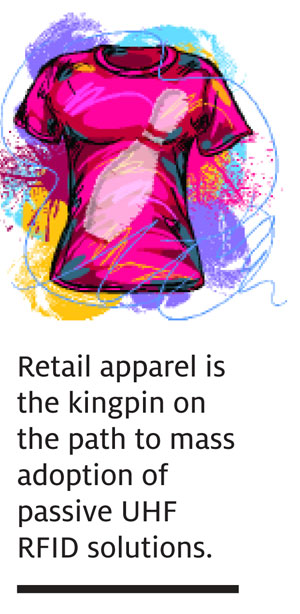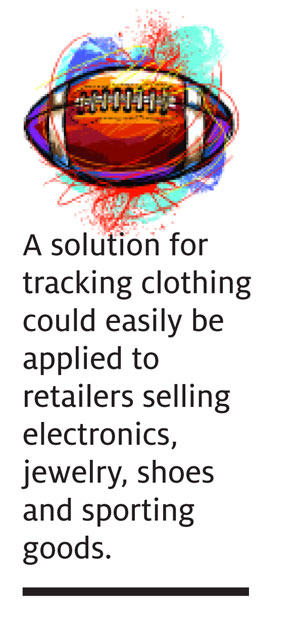Previously in this section, we have written about Geoffrey Moore’s technology adoption life cycle and how it applies to radio frequency identification. Specifically, we have looked at how close the RFID industry is to meeting the criteria he says are essential for a technology to achieve mass adoption: a global standard, a problem no other technology solves, a whole product, a “gorilla” (dominant provider) and a critical mass of end users.
RFID technology has matured and is being adopted by many companies in myriad industries. But in an interview for the special 10th anniversary edition of this magazine (see The Key to RFID Adoption)), Moore, author of Crossing the Chasm and Inside the Tornado, raises the possibility that RFID might never go mainstream—that it could remain forever in what he calls the “bowling-alley” phase of the technology adoption life cycle. There is a chasm between early adopters of a new technology and the majority of companies that adopt later, once the technology has gone mainstream, Moore says. When a technology crosses that chasm by proving its benefits, it enters the bowling alley.
|
|
“The bowling alley represents that part of the technology adoption life cycle in which your product gains acceptance from companies within the mainstream market but has yet to achieve general, widespread adoption,” Moore writes. “The goal of bowling- alley marketing is to keep moving forward toward the tornado [mass adoption], to progress from niche to niche, developing momentum. Each niche is like a bowling pin, something that can be knocked over in itself, but can also help knock over one or more additional pins.”
Is it possible that RFID will remain in the bowling alley? Yes. “For many customers, there is still plenty of life left in the old paradigm [technology] you are displacing,” Moore writes. “They might see the attraction of the new paradigm you are offering, but they have no compelling reason to move. Since infrastructure changes of any kind always entail hidden consequences, this part of the market instinctively holds back.”
Some high-value technologies get exploited economically, but they never become mass market, Moore tells RFID Journal. “Unix workstations are an example,” he says. “[Unix] is very valuable technology with a long life cycle, but [it] never became ubiquitous.”
But it is just as possible that RFID will knock down those bowling pins—if solution providers pursue the right strategies. Some vendors insist on trying to sell generic solutions. But during the bowling-alley phase, Moore says, it’s important for solution providers to focus on one vertical industry in which RFID can provide a huge benefit, such as apparel retail, because the technology cannot achieve mass adoption until it proves its advantages in at least one sector.
Solution providers also must make RFID easier to deploy. Currently, end users have to deal with the physics of radio waves, changes to operational practices, integration of new data and so on. What’s more, they often need to buy tags from one provider, readers from another and software from a third (at least with passive systems).
Once these issues are addressed, RFID will be ready to transition from the bowling alley to mass adoption. To take that step, the technology, ironically, must revert to being more generalized. A solution designed specifically to address the challenges of apparel retailers, for example, must be able to solve business problems in other industries as well.
There seems little question that active RFID technology could go mainstream. It is being used in many hospitals to track medical equipment. There is a problem other technologies can’t solve (a need to track assets in real time) and vendors offer whole solutions. But two factors continue to prevent more hospitals from deploying—lack of agreement on a standard and lack of a dominant player. Once those last two factors change, the health-care bowling pin will fall, and active RFID-based real-time location systems will become generalized for manufacturing, energy and other sectors.
Complexity is the main challenge for passive ultrahigh-frequency systems to overcome on the path to becoming a mainstream technology. Apparel retailers are using GS1‘s second-generation Electronic Product Code standard to improve inventory management. UHF technology has become easier to deploy. Tags are easier to read, readers have improved, and there’s a greater variety of form factors and antennas for different applications. The software for tracking inventory and other applications also has advanced.
But companies have to purchase tags from one vendor, readers from another and software from yet another, and then hire a systems integrator to put it all together and integrate it with back-end solutions. It seems likely that a group of companies will create a partnership and do enough deployments together that the solution will become highly repeatable, and less complex. This group will provide the whole product and emerge as the gorilla.
So retail apparel is the kingpin on the path to mass adoption of passive UHF RFID solutions. And a solution for tracking clothing could easily be applied to retailers selling electronics, jewelry, shoes and sporting goods. Retailers likely will get a lot of value out of RFID systems.
The question, then, is whether the hardware and software developed for the retail sector can be generalized to track anything—inventory, parts, people, returnable transport items, tools, work-in-process and more. The answer is almost certainly yes. Passive UHF RFID likely will become ubiquitous for tracking medium and small, inexpensive items in industries such as energy and manufacturing (large high-value equipment will be tracked with active solutions). RFID tags, readers and software all started as generic products that were later tailored to the specific needs of early adopters. Insights gained from the process of customizing solutions will be incorporated into generic products.
Another determining factor is that RFID is becoming easier to deploy in environments and on products less friendly to radio waves. Most radio-based systems improve over time as the technology evolves. Early Wi-Fi systems were slow and unsecured, and had spotty data transfers. Cell phone systems used to drop calls frequently. But coverage has improved, and the technology has evolved to a state in which cell phones are highly reliable.
Likewise, today’s RFID tags can be embedded in metal pipes, welded to metal, mounted to metal servers and storage devices in data centers and so on. Readers will no doubt continue to improve as well. While the technology will never be perfect—no technology ever is—it is likely that its reliability will be well beyond what most companies need to achieve business benefits.
Software also can be adapted. Many RFID software solutions already incorporate tools for configuring a variety of business-process applications. RFID software also might be absorbed into enterprise resource planning (ERP) applications or displaced by them—that is, ERP systems could evolve to encompass what RFID software does today.
It’s worth noting that bar codes started out in the retail sector and are now used in the aerospace, chemical, defense, electronics, pharmaceutical and transportation industries. RFID Journal believes RFID technology will become ubiquitous—as long as vendors pursue a strategy of focusing on a vertical, achieving market dominance in that sector and then using that leverage to transition to other verticals.
Six Tips for Marketing In the ‘Bowling Alley’
Geoffrey Moore argues in many of his books that providers of a new technology must adopt a marketing strategy appropriate to the technology’s current adoption phase. Here are some insights he provides for marketing in the bowling-alley phase.
1) Focus on a particular vertical industry. (Think of Apple‘s emphasis on the desktop publishing industry in the early days of desktop computing.)
2) Pick a niche—one in which a pressing need is unfulfilled, so there is a compelling reason to invest in a new technology solution.
3) Dominate that industry or niche, because pragmatists want to buy the solution everyone else is using.
4) Commit to completing your customers’ wish list, and build out your solution to meet all their needs.
5) Market to businesspeople, because the technology can deliver an economic benefit. The IT department is not interested in investing in a new, relatively unproven technology.
6) Adopt a solutions-oriented business model, in which each solution requires a significant amount of customization. (A project-oriented business model, in which the vendor makes money on each project, is appropriate for the early-adopter phase. A product model, in which the solution is standardized, works in the tornado phase.)
Illustrations: iStockphoto





